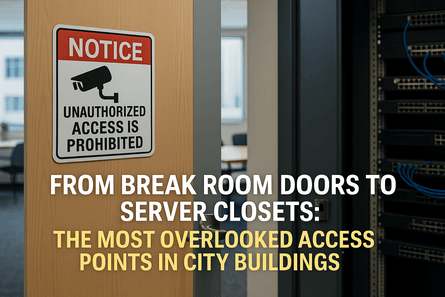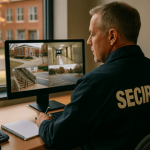
When it comes to physical security in government buildings, most municipalities focus on front entrances, public lobbies, and restricted office zones. These are the areas that get the cameras, keycard readers, and security signage. But the truth is, many serious vulnerabilities lie in the places that get the least attention—the service hallway, the side entrance, the storage room down the hall.
For local governments, every unsecured door is a potential risk. Whether it leads to sensitive infrastructure, shared office space, or even a network closet, these less-monitored points can be entryways for theft, data compromise, or unauthorized access. The goal isn’t to lock every single door, but to identify and secure the ones that matter most, even if they don’t seem critical at first glance.
Here’s a breakdown of the most commonly overlooked access points in municipal buildings—and what to do about them.
k
k
Break Rooms and Staff Entrances
Break rooms are often seen as low-risk, casual spaces. But they are typically located in less-visible areas of a building and may have exterior doors for deliveries or staff entry. These doors often lack strong access control or alarm monitoring.
Why it matters:
These side doors can be an easy point of unauthorized entry, especially if they are left propped open or shared among multiple departments. Once someone is inside, they can move freely through adjoining offices or storage areas.
What to do:
-
Add badge readers or keypad locks to employee-only entrances
-
Install door position sensors or alerting if doors are left open
-
Use signage that clearly marks these doors as restricted access
k
k
Janitorial Closets and Maintenance Rooms
It is easy to ignore utility spaces, especially if they are rarely accessed. But these areas often contain access panels, HVAC controls, or even unsecured crawl spaces that connect to other parts of the building.
Why it matters:
These doors are often unlocked or use universal keys shared across multiple facilities. This creates a chain of exposure that can bypass more secure zones.
What to do:
-
Assign unique access credentials for facilities teams
-
Use electronic locks with audit trails
-
Include utility areas in quarterly access audits
k
k
Server Rooms and IT Closets
In many older municipal buildings, network infrastructure is housed in rooms with outdated locks or no access control at all. These closets may be inside administrative areas, libraries, or multi-use buildings.
Why it matters:
If someone gains physical access to the city’s networking gear, they can bypass firewalls and gain entry into critical systems. This is a major cyber-physical crossover risk.
What to do:
-
Upgrade door hardware with smart locks or card readers
-
Enable role-based access control for IT rooms
-
Include these doors in your surveillance coverage
k
k
Internal Stairwells and Fire Exits
Stairwell doors are usually intended for emergency egress only. However, many remain unlocked from the inside, creating a potential entry point from multi-floor buildings or parking structures.
Why it matters:
An unsecured stairwell can allow someone to bypass front desk checkpoints and move between floors undetected.
What to do:
-
Use re-entry controls or alarms on internal stairwell doors
-
Monitor with surveillance or motion sensors
-
Mark all access points on emergency and lockdown plans
k
k
Copy Rooms, Storage Closets, and Shared Spaces
Rooms used by multiple departments tend to fly under the radar. These are often unlocked during the day and forgotten at night. Depending on the building layout, they may connect directly to more sensitive areas.
Why it matters:
Shared spaces can give access to sensitive documents, equipment, or unlocked staff terminals.
What to do:
-
Establish clear access policies for shared-use spaces
-
Lock doors after hours or on timed schedules
-
Add low-profile surveillance near entrances
k
k
Final Thoughts
City buildings are complex environments with dozens of access points beyond the front door. By focusing only on high-traffic areas, municipalities risk leaving critical vulnerabilities wide open. The solution is not more locks—it is smarter access control. Every door needs to be evaluated for its risk, usage, and proximity to sensitive assets.
SSP helps government clients conduct full-site assessments to identify overlooked access points and implement scalable solutions that reduce risk without adding friction.
k
k
See how SSP helps cities secure the spaces they often forget
From staff rooms to server closets, we design access control systems that match how your building is actually used—not just how it looks on paper.
Contact us for a walkthrough


